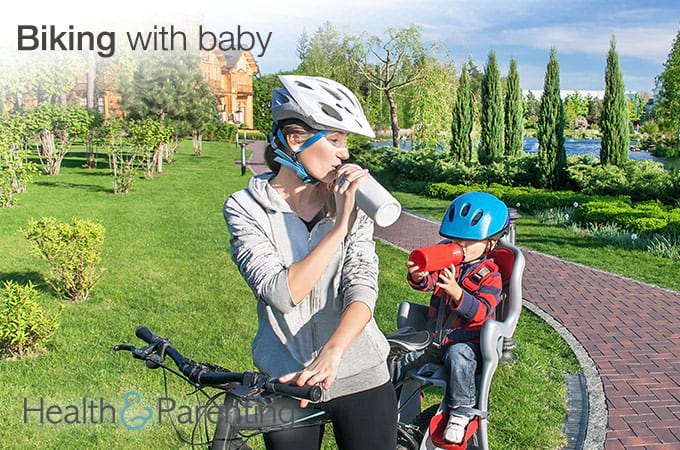Bicycling is a gentle way to ease yourself back into an exercise routine after the birth of your baby. But, can you bring baby along for the ride? The answer may depend on where you live. Check local laws (which typically have minimum ages) before riding with baby.
There’s not much research out there to support when it’s safe to bike with your baby. Health authorities in the UK and US recommend not biking with your baby until after your baby can sit well on his own (around age 9 months) when your baby has more stable head and neck control. Some suggest maybe not even until after your baby is one year old. In other countries, such as Denmark and the Netherlands where cycling is one of the preferred ways of getting around, riding with baby is much more common, even at younger ages. If in doubt, speak to your healthcare provider.
While accidents (falling or colliding with another vehicle) are a concern, the main worry with biking are the small bumps and jolts a baby without good head control will experience when riding even on everyday road, sidewalk or path conditions. Each of the bumps in the road can cause your baby’s tiny still-forming brain to move around inside the skull, with the potential for harm.
Safety precautions when riding with a baby include:
- Be sure the bike seat is correctly installed
- Babies should ride with an adult driving the bicycle, not with a sibling
- Do not carry your baby in a backpack or frontpack when cycling
- Your baby should always wear a lightweight, infant-sized bike helmet (though these may be difficult to find)
- You baby should be firmly strapped into an approved carrier or seat – whether on the back of your bike, or in a trailer towed behind the bike
- Bike in low-traffic areas, if possible
Keep in mind that carrying a baby on your bike will make you a little off balance, and will make stopping harder. You may want to consider the weight of the seat when deciding which to buy – heavier may mean a more difficult ride for you, while lighter may mean not quite as safe.
Types of seats for babies include:
- Rear Bike Seat: These seats are typically mounted to a rack on the back of the bike in order to support the weight of seat and passenger. Frame mount options are also available.
- Front Bike Seat: Mounted on the handlebars, these seats are best for children younger than age 3. While you might feel safer being able to see your baby as you ride, the seat itself may cause you to bump your knees as you pedal or to pedal bow legged (both of which may be less than comfortable).
- Bike Trailer: These carts attach to the rear axle or frame of the bike, and allow one or two children to sit or recline. They are typically covered and come with a windshield. Trailers are lower to the ground (so less chance of injury if the bike should tip), but they are often difficult for drivers to spot. Trailers can also make maneuvering more cumbersome, and may add quite a bit of weight to the biking experience.
- Box Bike or Cargo Bike (Bakfiets): These look like a cross between a wheelbarrow and a bicycle – the large open box in the front can carry your goods, including your child. Some cargo bikes have adapters that allow you to mount an infant seat in the cargo basket.
Before buying any seat, make sure it’s appropriate for your bike. Check to see that your bicycle has the correct type of handlebar connections with enough space for mounting a seat (for front mounted seats), enough frame space for the seat as well as your own body, and the correct mounting areas for trailers or rear mount seats. You’ll want to be sure mounting the seat doesn’t interfere with braking or with your ability to steer.
In addition, features such as kid handlebars, headrests, weather covers and windscreens may be important features for you. Adjustable straps that grow with your child (including foot straps) and always hold secure are the top safety feature to consider.
Do you enjoy biking with baby? How did you decide when and how?
Written by Michelle, childbirth instructor, lactation consultant, and mother to 4 busy kids
This information is not intended to replace the advice of a trained medical doctor. Health & Parenting Ltd disclaims any liability for the decisions you make based on this information, which is provided to you on a general information basis only and not as a substitute for personalized medical advice. All contents copyright © Health & Parenting Ltd 2016. All rights reserved.










